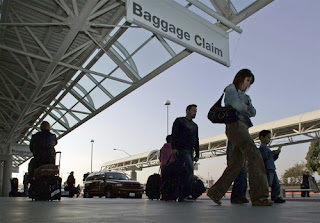 The Inland Empire facility's expected one-third drop in flights by fall is irritating travelers.
The Inland Empire facility's expected one-third drop in flights by fall is irritating travelers.Not long ago LA/Ontario International Airport was setting growth records. Airlines flocked to the Inland Empire airfield in what Los Angeles Mayor Antonio Villaraigosa hailed as the "great first steps" to regionalizing air travel in Southern California.
In a much publicized event last year, the mayor even helped welcome the start of an airline's service at Ontario by donning a safety vest and directing an ExpressJet plane to its gate.
Come September, ExpressJet will no longer operate at Ontario, becoming one of the latest casualties of high fuel costs and a souring economy, which have grounded airline service across the country. Other domestic airlines, such as United, Delta, Southwest and JetBlue Airways, have slashed or eliminated service at Ontario as well.
As a result, no airport in Southern California has been hit as hard by the aviation fuel crisis and downturn as Ontario. It is bracing for a 34% drop in flights from last fall's numbers, irking travelers and frustrating promises by politicians to shift some service away from congested Los Angeles International Airport.
Officials for Los Angeles World Airports say Ontario and LAX are being severely affected because they are neither hubs nor headquarters for major domestic airlines. When economic times are bad, they said, airlines concentrate flights at their hubs to save money and to take advantage of their established markets.
The hits come at a time when the Inland Empire is already suffering from the slowdown in the state economy and a meltdown in its once-booming housing industry because of the subprime loan crisis.
The cutbacks are "going to make it worse for us. We'll have to fly from LAX, and the lines there are 10 times worse," said Bob Surane of Thousand Oaks, coach of the Combat Panthers, a high school girls' traveling softball club from Ventura County that regularly flies out of Ontario to tournaments.
On Friday, Surane and members of the Panthers were waiting to check in at the ExpressJet counter for a flight to Tulsa, Okla. He said the team likes Ontario because of discounted airfares and the convenience of getting in and out of the terminals.
Philip Geurin, a student at Pitzer College in Claremont who flies home to Tulsa between sessions, said he too was disappointed by the decline in service.
"I love ExpressJet," he said. "They had pretty good fares and I could fly home nonstop. I am going to have to find another way."
By the end of the year, Ontario could experience the largest percentage drop in available seats -- about 14% -- compared with 2007 among all mid-size airports in the continental U.S.
Officials for Los Angeles World Airports, which operates LAX, Ontario and Palmdale Regional Airport, are worried that the number of travelers using Ontario could plunge dramatically next year, from 7.2 million passengers in 2007 to less than 5.2 million, a level not seen since 1989.
The drop-off could be so severe that one of the airport's two terminals would no longer be needed, a dramatic setback for Ontario's plan to accommodate more than 10 million passengers. More than $275 million was spent building the terminals, which opened in 1998.
The gloomy outlook has prompted an L.A. City Council committee that oversees the airports to meet Wednesday to discuss the pending decline in air service at LAX and Ontario as well as potential economic effects.
The decline will probably mean higher fares and fewer choices, factors that could discourage even more travelers from choosing Ontario. Many nonstop flights are being eliminated this fall, leaving passengers with little choice but to take a flight with one or two stopovers or drive to LAX.
"The business community will take a bit of a hit here in its effort to get to destinations important to them," said Ontario Mayor Paul Leon. "JetBlue and ExpressJet gave us an advantage."
Ontario isn't the only airport in Southern California facing such a predicament. With slowing demand and high fuel costs, airlines are retreating to larger airports such as LAX, where routes are more profitable, and eliminating duplicate service at nearby airports.
A third of the flights at Bakersfield's main airport, Meadows Field, will be slashed this fall. Responding to dramatic population growth, the city of about 300,000 residents had recently built a new terminal and extended a runway to lure more airline service.
As more carriers entered the Bakersfield market, "we ended up getting more competitive pricing," said Teresa Hitchcock, head of analysis and marketing for the airport. But now with airlines retrenching, "the big question is going to be how that affects fares."
Airports in smaller California cities such as Merced and Visalia are somewhat protected by a federal government program that pays airlines to provide service. Those communities were temporarily left without any scheduled service this summer, but by fall flights are expected to resume under the Essential Air Service program, which lined up other airlines to fly there.
Mid-size airports like Ontario have no such protection and as such are hardest hit by the industrywide retrenchment.
When Ontario built its two new terminals, airlines agreed to share the airport's operating costs with one another. Consequently, as airlines leave, the remaining carriers are left with a larger obligation and will have to pay more to keep the airport solvent.
Airport officials say they can cushion the blow at Ontario under a new U.S. Department of Transportation order that will allow revenue to be transferred from LAX to Ontario -- if LAX can afford it.
Ontario's comparatively low fares and high operating costs are compounding the problem. The airport has typically drawn discount airlines that don't offer more lucrative first-class seating or other amenities.
But with passengers accustomed to lower fares than elsewhere, airlines at Ontario have had difficulty raising ticket prices to levels they say they need to meet the rising costs.
"Ontario is a victim of the 'toos' -- too poor, too competitive and fares are too low," said Jack Keady, an aviation consultant based in Playa del Rey. "You have a low-airfare environment with high airline costs."
Jess Romo, the airport's director, said Ontario was taking a number of steps to reduce expenses, including turning off lights at unused gates, using its staff more effectively and pushing hard to attract other airlines to the airport.
The downturn "is a disappointment, but you have to keep it in the context of what is happening industrywide," Romo said. "If you just look at the geography of the airport, it still has the potential for growth. Politically, geographically and from a business standpoint, this airport is ready to accept more activity as the demand returns."
And L.A. Councilman Bill Rosendahl, who represents areas around LAX, insisted that the airline downturn wouldn't kill the idea of spreading air travel around to regional airports such as Ontario.
"Regionalism is not dead," he said. "There's going to be 25 million people from Santa Barbara to San Diego. There is a market for long-distance, nonstop flights at Ontario."



















1 comment:
More waiting at the airport!
Post a Comment